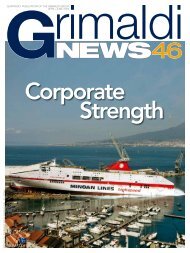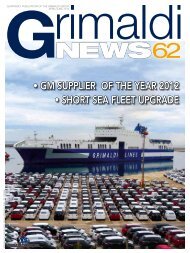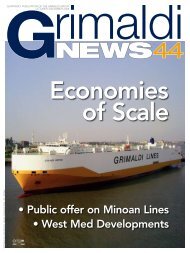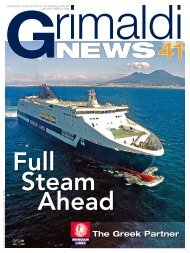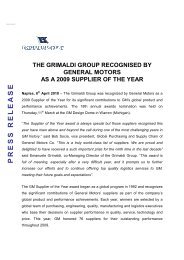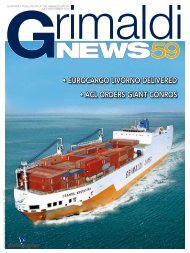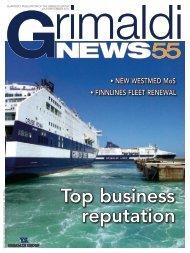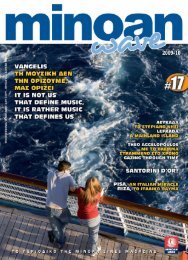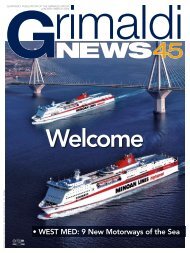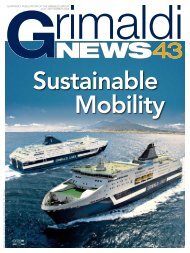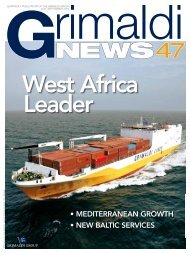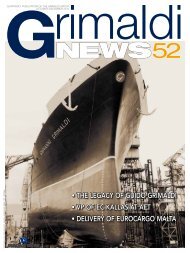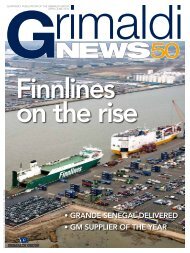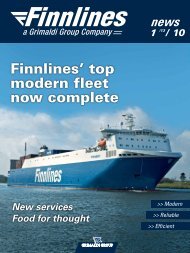In English (3.67 MB) - Finnlines
In English (3.67 MB) - Finnlines
In English (3.67 MB) - Finnlines
Create successful ePaper yourself
Turn your PDF publications into a flip-book with our unique Google optimized e-Paper software.
TransRussiaExpress (TRE)<br />
the rock in the surf for sustainability of utmost<br />
reliability for Russia for so many years<br />
Building a successful shipping business is about having the foresight to identify an opportunity,<br />
and the confidence to stand by your belief through good times and bad. <strong>In</strong> the Baltic, there is<br />
surely no better example of this maxim at work than <strong>Finnlines</strong>’ TransRussiaExpress (TRE) service.<br />
MS Translubeca in Kiel before the service was moved to Lübeck in 2002 & MS Transrussia serving the route Kiel-St. Petersburg<br />
Photos: <strong>Finnlines</strong> archive<br />
TRE was an immediate hit with its customers<br />
when it was launched as a direct ro-ro liner<br />
service between Kiel and St. Petersburg in<br />
February 1997. Fourteen years on, it has developed<br />
into a thriving business, with modern<br />
ships carrying cargo and an increasing<br />
number of passengers on a growing network<br />
of routings.<br />
12<br />
Bumpy road to success<br />
The years since the inauguration of the service<br />
were not always easy, however. <strong>In</strong>deed, it<br />
has been a slightly bumpy road from there to<br />
here, and it has required determination and<br />
self-belief to get this far.<br />
When TRE’s journey began, though, it was<br />
all downhill. The service debuted with two<br />
old Russian quarter-ramp ro-ros with capacity<br />
of 950 lane metres, and developed so fast<br />
that it was soon operating up to five ships<br />
with a total weekly capacity of 4,750 lm in<br />
both directions.<br />
The first bump in the road came in August,<br />
1998, when Russia’s economic collapse saw<br />
volumes in what had been a profitable service<br />
plunge 75 per cent almost overnight. <strong>Finnlines</strong><br />
and its then-partner TransLog (former BTS)<br />
kept the service running nonetheless, even if<br />
with only two ships, and slowly the market<br />
recovered.<br />
By 2000, they were investing again. The<br />
next-generation ro-pax Translubeca, with<br />
capacity for 1,750 lm of rolling cargo and<br />
84 passengers, was deployed on the route<br />
alongside the older 950 lm Transrussia. The<br />
addition of other <strong>Finnlines</strong> ships and chartered<br />
tonnage later boosted capacity to<br />
6,750 lm per week, while in 2002 the service<br />
was moved from Kiel to Lübeck.<br />
New vessels and ports of call added<br />
The global economic crisis that hit home in<br />
late 2008, however, delivered another blow<br />
to the service, with cargo volumes dropping<br />
abruptly by 70 per cent, this at a<br />
time when the Naplesbased<br />
Grimaldi Group<br />
had just taken over<br />
<strong>Finnlines</strong>.<br />
Undaunted, the new<br />
owners continued to invest<br />
in developing the<br />
service. Since then, it has moved towards a<br />
full ro-pax service with the addition in February,<br />
2009, of the Transeuropa, with its capacity<br />
for 3,200 lm and 124 passengers. The<br />
service has grown steadily over the last two<br />
years, and is now served by three vessels:<br />
Transeuropa and its sister ship Transrussia,<br />
formerly Finnhansa, and the smaller Translubeca,<br />
for a total of 8,000 lm per week.<br />
The service, which also calls at Sassnitz,<br />
has been expanded recently, with two



